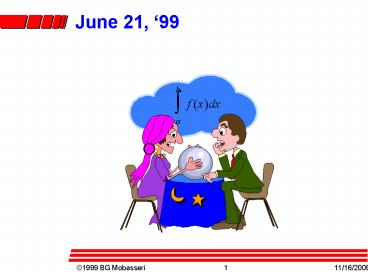June 21, 99 - PowerPoint PPT Presentation
1 / 33
Title: June 21, 99
1
June 21, 99
2
EVALUATING DEFINITE INTEGRALS
- MATLAB can evaluate definite integrals like
- This is provided that the integrand f(x) be
available as a function, not an array of numbers
3
HOW DOES MATLAB DO IT?
- The primary function for evaluating definite
integrals is quad8 - quad8 has the following syntax
- qquad8(function,a,b)
- This is equivalent to the expression
4
BUILT-IN MATLAB FUNCTIONS
- Evaluate the following
- Since cosine is a built-in MATLAB function
- yquad8(cos,0,3pi/2)
5
USER-DEFINED FUNCTION(we havent covered
function writing)
- You can integrate functions that are not part of
MATLAB library. - For example, you can write a function of your own
such as gauss,
6
Try it! area under humps
- humps is a pre-defined function in MATLAB. Lets
first plot it using - x00.012
- plot(x,humps(x))
- Now lets find the area over a number of
intervals - areaquad8(humps,0,0.5)
- areaquad8(humps,0,1)
- areaquad8(humps,0,2)
7
APPROXIMATION TO INTEGRALS - trapz
- Function trapz uses areas of trapezoids to
approximate the area under the curve
x00.012 yhumps(x) areatrapz(x,y)
You might be surprised how large the
answer is?answer next
8
Sample Spacing
- trapz assumes unit spacing between samples
- If that is not true, the output of trapz must be
scaled by the actual spacing, e.g. 0.1 - So what is the right answer in the previous slide?
9
In all future slides...
Use trapz in all future integration cases
10
Try it !
- Energy of a signal
- Using trapz, find the energy of a gaussian pulse
(slide 5) in the range (-1,1)
11
EXTENSION OF 1D INTEGRALS
- 1-D integral can geometrically be interpreted as
an area. - It is possible to evaluate volumes, not by
multidimensional integrals as is generally done ,
but as 1-D integrals.
12
DEFINING VOLUMES
- There are a number of ways a 3D shape can be
generated - Sweeping a Cross Section
- The Disc Method
- The Washer Method
- The Shell Method
13
CROSS-SECTIONAL METHOD
- Imagine sweeping a 1D shape, of varying cross
sections A(x), along a path. This action will
generate a swept volume.
c
b
a
x
14
VOLUME OF A PYRAMID
- In problems like this you must first do two
things - write a function for the cross section as a
function of x - determine the lower and upper limit of the sweep
h
x
b
15
THE DISC METHOD
- Take a 1D curve f(x) and revolve it around the
x-axis. This is a volume of revolution - semi-circle---gt sphere
- triangle --gt cone
- Every cross section is a circle. The radius of
the circle at xo is f(xo).
16
Try it! REVOLVING A SINUSOID
- Take one period of and
revolve it around the x-axis. Plot the shape then
find the volume of the revolution
17
THE SHELL METHOD
- Define a function f(x) in altxltb. Revolve R
around the y-axis - Examples
- revolve a rectangle --gt cylinder with a thickness
- revolve a circle --gt torus/donut
y
f(x)
18
Try it!
- Let f(x)1-(x-2)2 for 1ltxlt3. Revolve this around
the y-axis and find its volume
3
1
19
ARC LENGTH
- Another important application of integrals is
finding arc lengths
f(x)
x
a
b
20
PARAMETRIC CURVES
- It is frequently easier to work with a parametric
representation of a curve,i.e. - xf(t)
- yg(t)
- For example, a circle
- x(t)rcos(t)
- y(t)rsin(t)
r
t
21
LENGTH OF PARAMTERIC CURVES
- Using derivatives of f(t) and g(t)
22
CYCLOID
- Path length traversed by a point on a wheel is of
interest
P
P
x
P
full perimeter2.pi.r
23
LENGTH OF A CYCLOID
- The parametric equation of a cycloid with r1 is
given by - xt-sin(2.pi.t)
- y1-cos(2.pi.t)
- First, plot the cycloid for 0lt t lt1.
- Then find its length for one cycle and compare it
with the horizontal distance
24
INTEGRALS IN POLAR COORDINATES
- A curve can be represented in polar coordinates
by - Equivalently
???
y
???
x
25
CURVE LENGTH
- The length of a curve represented in polar
coordinates is given by
26
PERIMETER OF AN ELLIPSE
- Find the perimeter of an ellipse given by
27
cardioid, 3-leaved rose
- cardioid is defined by r1cos?.
- 3-leaved rose is given by rcos3?.
28
LENGTH OF A cardioid
- We need the derivative of f(??
- f(????-sin(??
- Then,
29
AREA IN POLAR COORDINATES
f (?)
30
AREA OF AN ELLIPSE
- For the ellipse given by
- find its area and verify
31
AREA OF A cardioid
- Here we have
- Then
32
HOMEWORK-1
- Find the length and area of a cardioid. Use the
relevant equations for length and area given
previously
33
HOMEWORK-2
- Find the energy of the bond clip using trapz.
This routine assumes unit sample spacing.
However, bond is sampled at 8KHz. Take this into
account.































